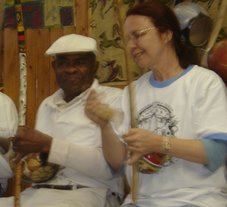Continuing where I left off a while back
Back then, Ilê Axé Opô Afonjá had a shop at the Hotel Pelourinho in the historic district of Salvador, which sold beads and all the other items that Orisha worshippers require. I went there straight after my first meeting with Mãe Stella and asked for Oshun beads. They asked me, which kind? I had no idea. Was my Oshun young or old? I didn't have a clue. So I decided to go for the colour that "spoke" to me. I have always liked yellow and yellow-brown stones - cat's eyes, brown and yellow topaz and amber, so I chose the dark amber beads and later had them "washed" with herbs to make them sacred. Otherwise, they'd just be a necklace. I found out soon afterwards that I'd made the right choice.
At some point during my wanderings that day, I stopped by the fort (now the Capoeira Fort) in Santo Antonio Além do Carmo. GCAP was closed for the day, but João Pequeno was sitting alone in his school right below it, on the ground floor. I walked through the door that gave onto the courtyard and greeted him, telling him of my decision to stay. I don't remember his exact words, but the idea behind them was clear - I had to stay in Bahia and help develop Capoeira, for myself and others.
So I stayed on, training three times a week, with "rodas" on Saturdays and Sundays. I've been asked about those training sessions, so I'll try to describe them - we formed rows and did certain moves over and over and over again, individually at first, then in pairs. Practicing the negativa that way was good for me because it built up my upper arm strength - something that is generally a challenge for women in Capoeira. It's the move that allows you to keep low to the ground while someone's foot or leg sweeps over you. Your arms take your weight as you lower your entire body to the ground, so you can spring up and smoothly move into a counterattack.
Training at GCAP was very different from learning the Regional style, which generally involves set sequences of defensive and offensive moves. We learned our Angola moves one at a time and only put them together in the "roda." We also practiced handstands, backbends and aus (cartwheels) - but the slow low style, not the high flashy Regional "star".
I'll never forget that, when I met up with Paris in São Paulo that year - the last time I'd see him, as it turned out - he asked if I'd finally learned the au. It was the one thing I thought would be easy and turned out to be impossible - at least, in LA. He was impressed when I said I finally had - but unfortunately I couldn't show him because we were in a busy bus station at the time. So the method worked. I also learned to walk on my hands and do front flips (but never back flips) and continued to play in the "roda" until I was seven months pregnant in 1988. (To be continued...)
Saturday, 6 September 2008
Subscribe to:
Post Comments (Atom)


1 comment:
Hallo!
Excellent posting!!!
Congratulations!!!
Have a nice weekend.
Post a Comment